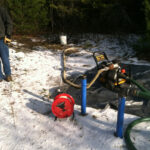Developing new wells on District-owned property and remediating MtBE found at one site
The Mountain Lakes District in Haverhill, New Hampshire provides water to over 320 residential service connections along with a lodge and an office. The District currently obtains approximately half of the supply from its own well sources and purchases the remainder from a nearby water system. The District wishes to reduce or eliminate the amount of water that it purchases by developing a new well(s), preferably on District-owned property.
Nobis was retained to seek a gravel-packed well site that taps a mapped stratified drift aquifer underlying part of the District, as the District has had limited success with bedrock wells in the past. Nobis helped the District investigate all District-owned properties and some abutting properties that overlie the mapped aquifer and installed test wells at selected locations. At one location, a productive test well was found to be impacted by MtBE.
Nobis then leveraged funds available from the New Hampshire Department of Environmental Services (NHDES) MtBE fund and conducted an investigation and remediation program that achieved a progressive reduction in MtBE concentrations, which resulted in laboratory “non-detects” in a few years. With the resolution of the MtBE occurrence, Nobis and the District have renewed consideration of the best options for obtaining new wells on District property to reduce or eliminate purchasing water from the nearby water system. This work is ongoing.
challenges
- Previous District efforts to locate a high-yielding bedrock well had been unsuccessful.
- A mapped overburden aquifer traverses the District but is limited in depth and width, with only a few District-owned properties available overlying the aquifer and having sufficient size for required Sanitary Protective Area radii and setbacks from wetlands.
- MtBE was found in groundwater at one of the most promising District-owned sites.
solutions
- Nobis and the District visited all District-owned properties that overlie the aquifer and some abutting properties to determine their suitability for future water supply development. Test wells or test pits were installed on appropriate properties to refine the list of suitable sites.
- Nobis worked with the District and the NHDES to properly report the MtBE contamination at one of the sites and obtain funding for the District to investigate and remediate the groundwater impact at no cost to the District.
- Using a variety of methods that included geophysics, exploratory drilling, and pumping to remove impacted groundwater, Nobis determined that there were no significant remaining MtBE sources and that a small, local, historical discharge was likely responsible for the observed groundwater impacts. A preliminary pumping program from the most-impacted location and depth significantly reduced MtBE concentrations. A secondary pumping program resulted in non-detections for MtBE.
- In consideration of future District plans, the extraction well installed for MtBE remediation was constructed to Community Water System well standards and is now available for further testing and permitting as a potential new water supply for the District.
results
- To identify locations suitable for developing a new water supply well, several District-owned properties that overlie the overburden aquifer have been assessed, investigated, and ruled out, with a smaller group of sites still in consideration.
- One of the sites was impacted by a historical release of MtBE. Nobis worked with the District and NHDES to successfully address these impacts, at no cost to the District, in a manner that allows further testing in support of developing a new water supply.
- Investigations and discussion to determine the best water supply options and consider costs for the District resumed and are ongoing.


